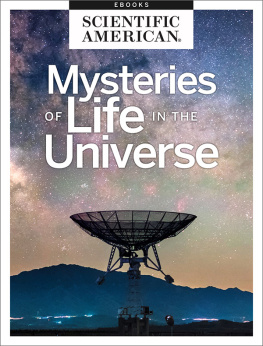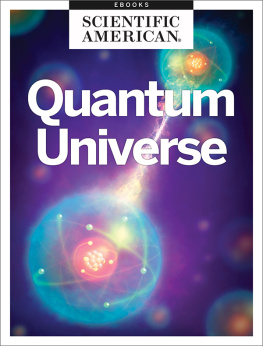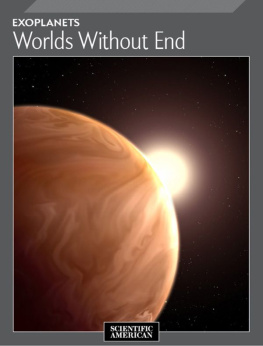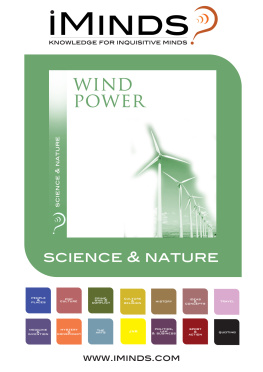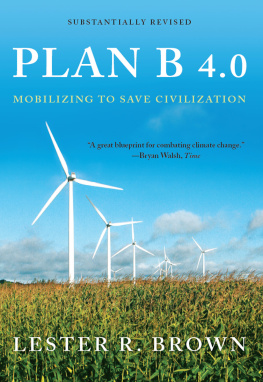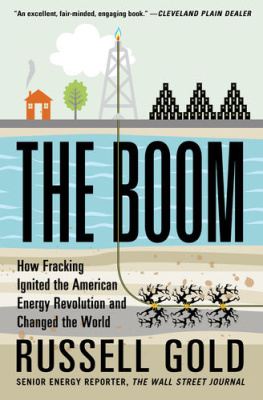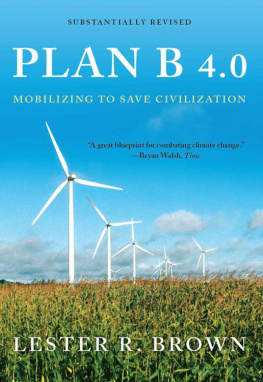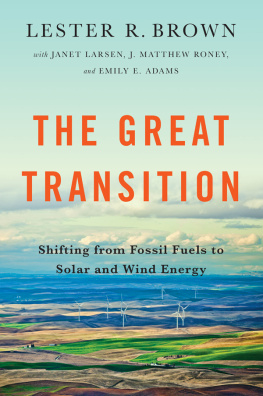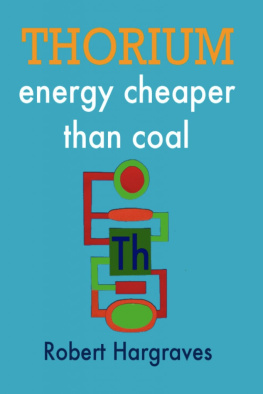THE FUTURE OF ENERGY
From the Editors of Scientific American
Cover Image: Michael Betts/Getty Images
Letters to the Editor
Scientific American
One New York Plaza
Suite 4500
New York, NY 10004-1562
or editors@sciam.com
Copyright 2017 Scientific American, a division of Nature America, Inc.
Scientific American is a registered trademark of Nature America, Inc.
All rights reserved.
Published by Scientific American
www.scientificamerican.com
ISBN: 978-1-466833869


THE FUTURE OF ENERGY
From the Editors of Scientific American
Table of Contents
Introduction
by Jesse Emspak
Section 1
1.1
by Mark Z. Jacobson and Mark A. Delucchi
1.2
by the Editors
1.3
by Michael E. Webber
1.4
by David Biello
Section 2
2.1
by Ken Zweibel, James Mason, and Vasilis Fthenakis
2.2
by George Musser
2.3
by Antonio Regalado
Section 3
3.1
by David Biello
3.2
by David Biello
3.3
by Sarah Wang
Section 4
4.1
by Adam Piore
4.2
by Matthew Wald
4.3
by Joseph F. Geoff Brumfiel
Section 5
5.1
Linda Church Ciocci
5.2
Larry Greenemeier
5.3
Larry Greenemeier
5.4
Adam Hadhazy
Section 6
6.1
Jane Braxton
6.2
Mark Fischetti
Section 7
7.1
by Melinda Wenner
7.2
by John B. Reynolds
Section 8
8.1
by Matthew Wald
8.2
by Davide Castelvecchi
Introduction: Now or Never
Since the Industrial Revolution our civilization has depended on pulling fossil fuels out of the ground to generate energy. First coal, then petroleum. But there are two problems: first is that petroleum isn't an infinite resource. The most readily available sources are tapped out or nearly so, and oil companies are forced to look for supplies in more remote and dangerous places. The second is that burning coal and oil puts billions of tons of carbon dioxide into the atmosphere.
Carbon dioxide is a very efficient way to trap heat. Over the last century humans have managed to raise temperatures by about 0.6 degrees Celsius. That may not sound like much, but even that small increase is showing some large effects: records have been set for the seasonal loss of arctic ice. If business as usual continues, the human species is looking at a world where sea levels will be high enough to submerge many coastal cities, and extreme weather events are the new normal. It's plain something has to be done, and soon.
In this eBook, The Future of Energy: Earth, Wind and Fire , we review the energy problem and analyze the options from the mundane to the radical. It is after all eminently possible to use our technical ingenuity and get ourselves out of this mess, as discussed in the two opening pieces: A Path to Sustainable Energy by 2030 and 7 Radical Energy Solutions. We can find and develop sources of energy that don't require putting carbon into the atmosphere, as well as avoiding the trade of one limited resource for another.
It wont be easy. Our whole infrastructure is designed around a continuous supply of power (called baseline generation). We've also poured trillions of dollars into drilling, refining and transporting oil.
It isn't as though the energy sources arent there. The sun, earth and oceans all have more than enough to supply human civilization many times over. And renewable energy is more than photovoltaic cells and wind turbines. In Section 3, we discuss hydropower, including stories on how tides could power coastal cities. Section 5 examines geothermal powerplants could be built over much of the American west. Even nuclear fission could see a renaissance, and there's the possibility of fusionusing the power of the sun itself.
All of these technologies have drawbacks that must be addressed. Nuclear plants are expensive to build, and there are still concerns about safety. Solar power is still relatively expensive, and wind doesn't operate all the time. Fusion is still a nascent technology, with no guarantees that it will work.
Meanwhile we need to power transportation, and that means automobiles. Biofuels might be a solution there. If a cheap alternative to gasoline that doesn't impact the food supply can be found, it would radically alter the economics and environmental effects of driving.
And contrary to popular belief, changing to renewables needn't mean privation and austerity. Section 3s Tales from a Small Island shows how one part of Denmark has been able to maintain a relatively rich economy while reducing carbon emissions.
Yes, our lives will change. That doesn't always mean for the worse. When the price of labor rose, the armies of servants that populated British manor houses were greatly reduced as technologies such as vacuum cleaners and washing machines took their place. Few would say the occupants suffered for it.
Not every idea will succeed. That isn't the point. There's no choice but to change the way we power our lives. The question is how and when. The longer we wait, the more painful the transition will be.
-Jesse Emspak
Book Editor
SECTION 1
Sustaining the Earth, Sustaining Ourselves
A Path to Sustainable Energy by 2030
by Mark Z. Jacobson and Mark A. Delucchi
In December 2008 leaders from around the worldwill meet in Copenhagen to try to agree oncutting back greenhouse gas emissions fordecades to come. The most effective step to implementthat goal would be a massive shift awayfrom fossil fuels to clean, renewable energysources. If leaders can have confidence that sucha transformation is possible, they might committo an historic agreement. We think they can.
In 2008 former vice president Al Gorethrew down a gauntlet: to repower Americawith 100 percent carbon-free electricity within10 years. As the two of us started to evaluate thefeasibility of such a change, we took on an evenlarger challenge: to determine how 100 percentof the worlds energy, for all purposes, could besupplied by wind, water and solar resources, byas early as 2030. Our plan is presented here.
Scientists have been building to this momentfor at least a decade, analyzing various pieces ofthe challenge. Most recently, a 2009 StanfordUniversity study ranked energy systems accordingto their impacts on global warming, pollution,water supply, land use, wildlife and otherconcerns. The very best options were wind, solar,geothermal, tidal and hydroelectric powerall of which are driven by wind, water orsunlight (referred to as WWS). Nuclear power,coal with carbon capture, and ethanol were allpoorer options, as were oil and natural gas. Thestudy also found that battery-electric vehiclesand hydrogen fuel-cell vehicles recharged byWWS options would largely eliminate pollutionfrom the transportation sector.
Our plan calls for millions of wind turbines,water machines and solar installations. Thenumbers are large , but the scale is not an insurmountablehurdle; society has achieved massivetransformations before. During World War II,the U.S. retooled automobile factories to produce300,000 aircraft, and other countries produced486,000 more. In 1956 the U.S. beganbuilding the Interstate Highway System, whichafter 35 years extended for 47,000 miles, changingcommerce and society.


